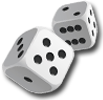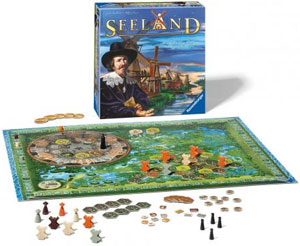



play board games
Board game reviews, strategy tips & session reports
Seeland Board Game Review
 Stats:
Stats:
No. of players: 2-4
Amount of time to play: 60 min
Age requirements: 9+
Set-up time: 5 min
In Seeland you play a land buyer in the Netherlands looking to gain power and prosperity. You must build windmills and grow plants to score the most VPs and win.
Seeland Description:
Seeland is a tile-laying game with a rondel that determines which tiles you may place on the board. There are three types of tiles landscape tiles, windmill tiles and farm tiles. Landscape tiles may be bought in the market or revealed on the map, windmill tiles are only available in the market and farm tiles may only be found on the board.
There are three phases on each of your turns, purchase, reclamation and harvest. During the purchase phase you take a landscape or windmill tile from the market. The market is a rondel with an inner and outer track. The inner track contains the guild master and the tiles you can take. The outer track has your pawn and five guilders. The guild master starts on a blank tile space and must move at least one space forward. This movement is free, but you can move him forward more spaces but must move your pawn forward on outer track one space for each extra space he moves. You can never move beyond the farthest guilder. The guilders move forward on the outer track once no pawns are on it.
In the reclamation phase you place the tiles you just purchased. Landscape tiles must be placed next to one of your windmills. Windmill tiles may be placed to a previously placed tile. If a windmill is placed next to any face-down tiles on the board, they are revealed. They may be landscape tiles or a farm tile. If it is a farm tile you get a coin. You also start the game with one coin and you can spend one to take an entire turn right after your first is over.
The last phase is harvest and it doesn’t occur every turn. If you have a windmill that is surrounded by tiles you harvest score. Scoring is calculated by adding the values of the land tiles adjacent to the scoring windmill. If you have all three landscape types you score five bonus points. But if you have only one type of landscape you score no points.
This continues until the pile of landscape or windmill tiles is empty. Then the game is almost over. Any player can choose (or be forced) to move the guild master onto an empty space in the market and end the game. The player with the most VPs wins.
There is also an advanced variant. It adds a bonus for scoring the most total VPs on a single harvest action. It also adds governors. These pawns are added to the board when they are shown on a just placed landscape tile. They score you five VPs but require you to score a minimum number of points. The minimum score is based on a number by the farthest guilder on the market rondel.
Quick Review of Seeland:
Seeland is a fun that plays fast. Even with the variant the game is easy to teach and play. It adds ways to score but not a ton of complexity.
The components for this game are very good. The map, tiles and chits are good quality. The rules are easy to read and follow. I do wish the player colors were different. As they are now they are a bit drab.
The first thing I like about Seeland is the variety of ways you can play it. In addition to the variant there is also a side of the board with preprinted island spots. You can even play with the initial tiles placed on the board face up. Both of these options make the game more strategic and less random.
I also like how the variants add flexibility to this game. The different modes of play helps it cater to different gamers and groups of people. You can play this without any variants and enjoy it with kids and non-gamers. While most gamers can jump in feet first with the advanced variant. This also lets you introduce the game easier and then add on more options later.
The gameplay is solid and scales really well too. You need to manage the rondel more in a two player game but the experience is fun with two, three or four.
This game is not perfect though. Some gamers may not like the theme or the game’s simplicity.
Seeland is a fun game and can fill a couple niches in your board game collection. It can be a gateway game and is great for showing new gamers a rondel and tile-laying. It is also really good for families and on game nights given the different ways you can play it. If you are looking for a flexible board game that is accessible and fun for all, pick this one up.
Score and synopsis: (Click here for an explanation of these review categories.)
Strategy 3 out of 6
Luck 4 out of 6
Player Interaction 4 out of 6
Replay Value 4 out of 6
Complexity 3 out of 6
Fun 4 out of 6
Overall 4 out of 6

Leave a Reply